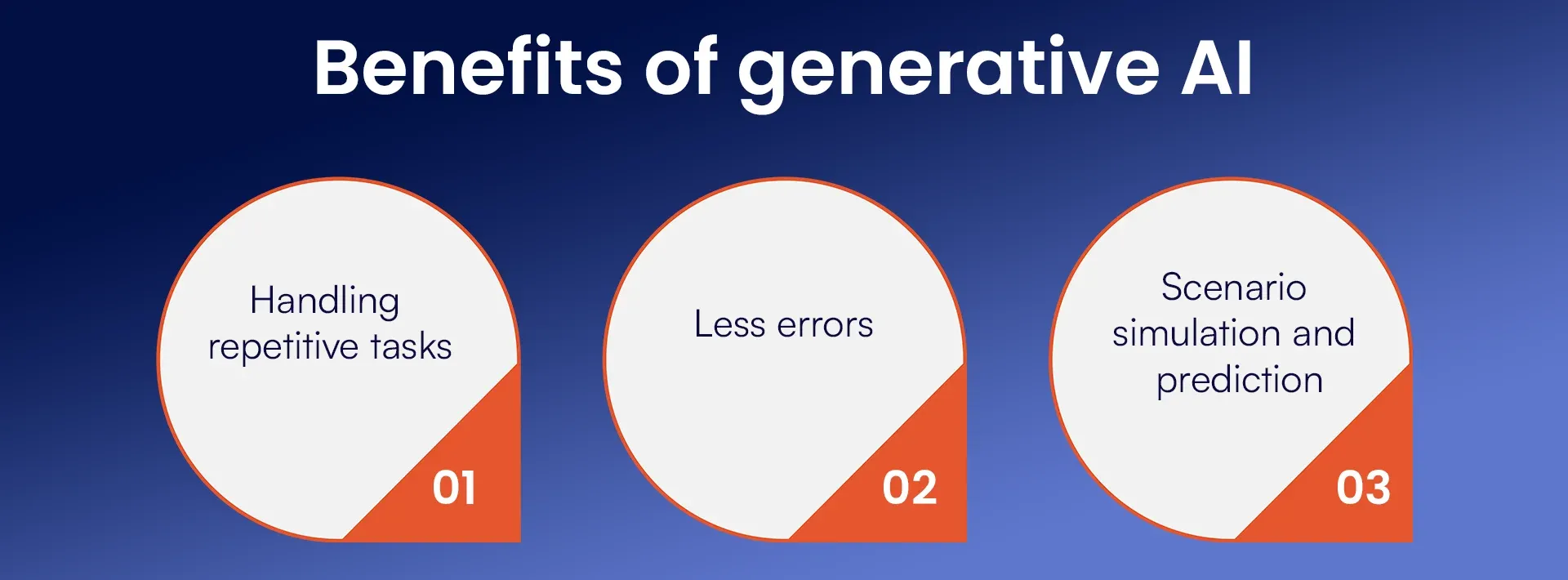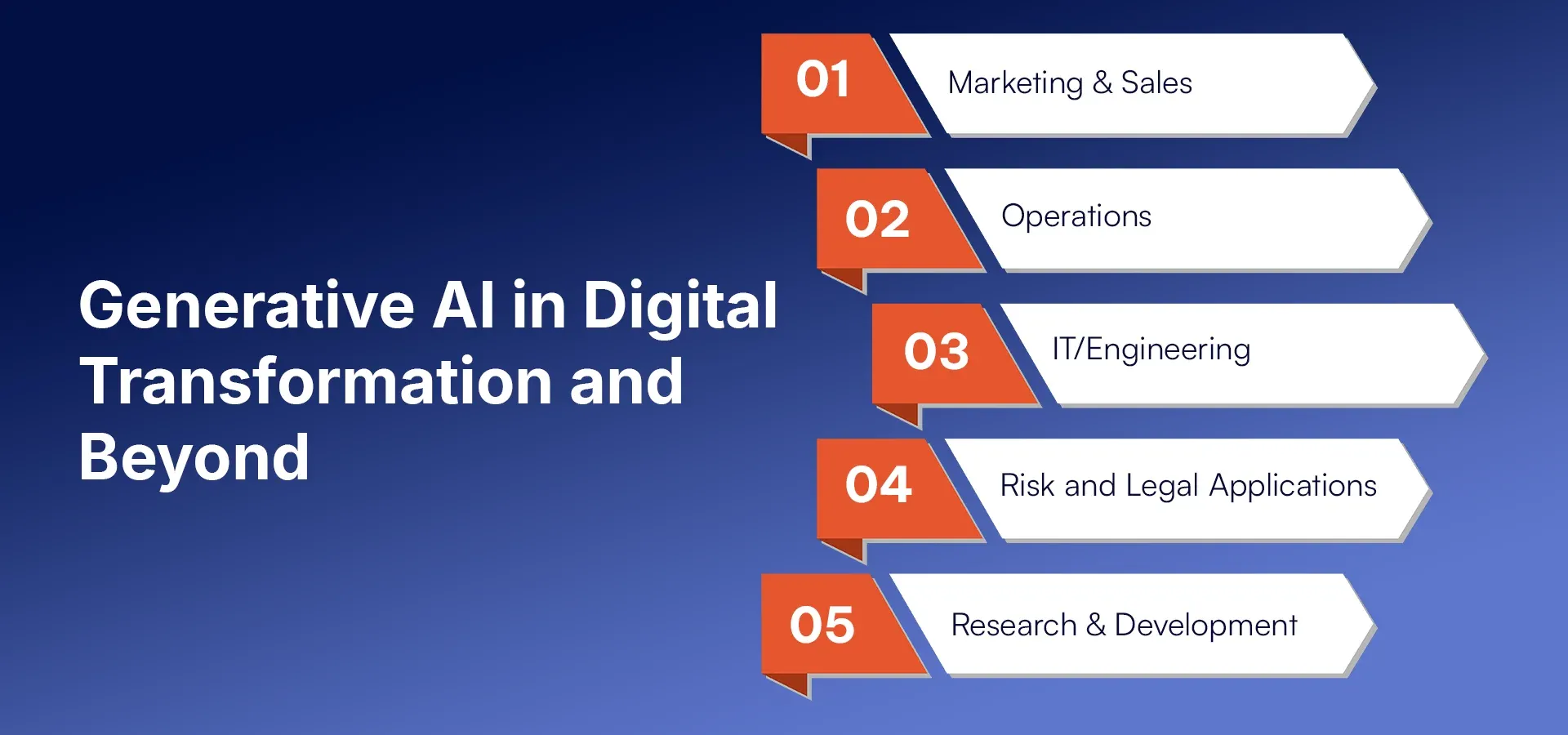
The world keeps moving fast, and our tools keep getting smarter. Think about the old days of the internet. It was slow and clunky. Now we have lightning-fast connections and machines that guess our every need. Generative AI sits right at this intersection. It can conjure new text or images. People talk about digital transformation all the time. But what does that even mean? It’s about shifting old ways of working into digital methods. The cool part is that generative AI does not just tag along for the ride. It pushes everything forward. This blog tries to shed light on how. Let’s look closer and see what’s going on with applied generative ai for digital transformation.
Things are getting smarter. Machines don’t just follow rules. They create outputs that feel real. Businesses shift from dusty paper to digital platforms. Generative AI is not just a tool; it’s a partner that shapes strategies. It drives digital transformation using ai in ways that feel effortless. You can see it making marketing content more catchy, letting companies stay ahead of the pack. This is not magic. Anyone who invests time can gain value. It’s about breaking old patterns. It’s about digital transformation ai in everyday work. The result is a world where human effort pairs with machine creativity. This field keeps surprising everyone.
What is Generative AI?
Generative AI refers to tools and techniques that produce new content. It might be text that reads like a human wrote it. It might be an image that looks handcrafted by a skilled artist. It might be code a developer can trust. This technology relies on models trained on large data. It tries to understand patterns, then create something fresh. It differs from old-school AI, which often just recognized things. Generative AI tries to make new stuff. In short, it’s like a clever machine that can daydream in code. It’s key to ai for digital transformation. People see it as a new wave of innovation, turning vague hints into something tangible.
What is digital transformation?
Digital transformation means shifting from old-school ways to methods that fit our modern world. It often means ditching paper records for online systems that run 24/7. It might mean a website that accepts orders anytime or a tool that analyzes customer behavior. Companies talk about digital transformation using ai because they want to remain competitive and flexible. It’s not just a fancy term. It’s a necessity. Every industry can improve by digitizing core processes. This involves apps, platforms, and analytics. When combined with AI, it reshapes how we interact with technology. It’s not just a cosmetic change. It’s a fundamental shift in getting stuff done.
Benefits of Generative AI
Generative AI brings many benefits. It’s fast and surprising. It can write product descriptions or draft emails that sound natural. It can design prototypes without human fuss. It can speed up workflows and reduce overhead. It makes digital transformation ai more than a slogan. It pulls in data, grasps patterns, and spits out results that guide decision-makers. It lets businesses adapt. It’s like having a creative assistant who never tires. This tech brings fresh perspectives. It doesn’t demand coffee breaks. It just keeps producing. For anyone serious about rethinking old strategies, generative AI stands ready to help.

1. Handling repetitive tasks
Repetition is a big pain. It’s dull and leads to slip-ups. Generative AI can tackle that. It can handle tasks that bore humans. Instead of someone rewriting the same text, a model can do it in seconds. Humans can focus on trickier problems. Picture a support team answering the same question 500 times. A generative model can draft responses that sound fresh and do it endlessly. That’s how applied generative ai for digital transformation works. It gives people back their time.
2. Less errors
Humans get tired. Mistakes happen. Generative AI tries to avoid silly slip-ups. It can check itself and follow patterns carefully. It does not have moods or distractions. As long as data is solid, it maintains consistency. Less human intervention often means fewer mistakes. That leads to better quality, more trust, and smoother operations. Combined with digital transformation using ai, it sets a high standard. By handing tasks to models, we cut down on human error. It’s not perfect, but it’s a step forward.
3. Scenario simulation and prediction
Generative AI can imagine what might happen next. It can run scenarios and suggest outcomes. This helps with planning. Maybe a company wants to guess how a product launch will go. The model sifts through past data and produces possibilities. Maybe it looks at market shifts and forecasts trends. This helps businesses make informed choices. Instead of shooting in the dark, they get a head start. It’s not foolproof, but it’s better than guesswork. By letting AI paint a picture of the future, organizations can pivot wisely.
4. How AI Is Changing Business?
AI is not just for tech giants. It’s everywhere. Retailers use it to recommend products. Banks use it to spot fraud. Media firms use it to create content. The shift is huge. AI doesn’t just improve results; it changes how we think about work. It handles massive data sets without blinking. It offers insights that were once hard to get. It can spark new business models. AI is baked into digital transformation AI efforts in every sector. It’s no longer “if” a company should consider AI. It’s “how soon” they jump in.
Examples of generative AI inspiring digital transformation
When we talk about applied generative ai for digital transformation, real cases help.

1. Market analysis
A company faces oceans of market data. Generative AI can sort this chaos. It can write summaries that make sense of shifting demands. It can highlight potential gaps. It can guess what consumers want next quarter. Instead of hiring armies of analysts, firms rely on AI that digs in instantly. This speeds decisions and helps them top slower rivals.
2. Email categorisation
Inbox overload is real. Generative AI can sort and reply. It groups messages by topic or urgency. It drafts replies to simple queries. This cuts drudgery and improves response times. Clients get faster help. Workers suffer fewer headaches. In a world that prizes speed, this matters.
3. Retail supermarket
A supermarket chain sells thousands of products. Generative AI watches buying habits, notes trends, and predicts next week’s hot items. It suggests pricing or drafts product descriptions. It helps design better layouts or plan promotions. This lifts retailers out of guesswork into informed decisions.
Also Read : Generative AI in healthcare industry
Role of Generative AI in Digital Transformation
Generative AI steps into the digital transformation spotlight by moving beyond basic automation. Without AI, digital tools might feel static. With AI, they gain creativity. They don’t just store data; they produce suggestions. They don’t just respond; they predict. With generative models, digital transformation using ai is not just talk. It’s a shift where software takes on a proactive role. Companies become more agile and ready for surprises.
Generative AI and Digital Transformation Explained
Digital transformation is about going digital. Generative AI is about producing new things. Combine them, and you get a system that not only automates old tasks but invents fresh ideas. Instead of just digitizing forms, companies can have AI rewrite manuals, propose prototypes, or brainstorm marketing angles. Instead of just shifting data online, they let AI predict patterns. This synergy makes ai for digital transformation practical. The future is not just digital. It’s also creative and smarter than before.
Some examples of generative AI tools
The world of generative AI is big and varied. A few tools stand out. They differ in features, but share a goal: help humans produce things faster and better.

1. ChatGPT
ChatGPT is a chatterbox that never sleeps. It answers questions, writes content, and suggests ideas. It was learned from mountains of text. Its tone feels human. That makes it handy for drafting emails, product descriptions, or blog posts. For businesses exploring digital transformation, ChatGPT is a friendly start. It needs no special skill. Just a prompt and a spark of creativity.
2. DataRobot
DataRobot focuses on the machine learning lifecycle. It helps build, deploy, and manage models. While not purely generative, it predicts outcomes and handles big data. Companies can test ideas quickly. They get models that fit their data. It’s not magic, but it’s a robust helper for scaling AI. Combined with generative methods, it brings richer insights.
3. Hugging Face Transformers
Hugging Face is a hub of language models. Transformers power many generative systems. This platform gives developers libraries to build custom models. Teams can create text generators, translators, or summarizers. It’s technical but offers control. For companies wanting more than off-the-shelf solutions, Hugging Face is a resource goldmine.
Generative AI in Digital Transformation and Beyond: Business Use Cases
Generative AI isn’t stuck in one domain. It can thrive in marketing, operations, IT, legal, and research. As companies embrace digital transformation using ai, they see how these tools can boost processes and spark ideas. It’s not about replacing humans, but giving them new capabilities. Business life is full of repetitive tasks and tough puzzles. Generative AI can handle some parts and guide the rest.

1. Marketing & Sales
Marketing teams want fresh content. They need catchy campaigns and smart ad copy. Generative AI can draft slogans and social posts. It can analyze reviews and find common themes. Sales teams benefit too. They get quick summaries of leads. Instead of trawling databases, they let AI highlight key points. The result: faster sales cycles and more targeted outreach.
2. Operations
In operations, detail matters. From supply chain logistics to shift schedules, everything must run smoothly. Generative AI can suggest when to restock or how to arrange deliveries. It can prepare internal reports instantly. Instead of hours crunching numbers, a model can summarize in seconds. Teams react faster. This is what makes applied generative ai for digital transformation so valuable.
3. IT/Engineering
IT and engineering deal with documentation, troubleshooting, and code maintenance. Generative AI can provide code snippets, explain configurations, or highlight patterns in logs. Instead of hunting forums, an engineer might ask the model. It’s like having an intern who reads all the manuals. Not flawless, but it cuts guesswork. For big teams, it means gains in efficiency.
4. Risk and Legal Applications
Risk management and legal work demand precision. Documents are long and dense. Generative AI can summarize contracts or highlight key terms. It can read regulations and produce short guidance. Compliance teams check policies quickly. Legal teams get clause drafts. It doesn’t replace lawyers, but saves time. Companies spot red flags early and stay safe.
5. Research & Development
R&D needs new ideas. Researchers sift through articles and patents. Generative AI can summarize findings, propose variations, or suggest experiment directions. It can help draft initial research papers. This reduces grunt work. Researchers focus on shaping theories. The model offers hints they might miss.
Conclusion
Generative AI isn’t a passing trend. It shapes how we think about digital tools. Instead of machines that only store data, we have models that produce. That changes the game and makes digital transformation run deeper. Companies can start small-maybe generate a product description and scale up. Stay curious, test ideas, and refine approaches. Old processes fade, and fresh methods take their place. Businesses that act now might find themselves better prepared for tomorrow. If you also want to digitally transform your business then you can contact us because we provide the best services of Artificial Intelligence. We, at Rejoice, can guide you through this maze.
Frequently Asked Questions
1: How Does Generative AI Differ From Traditional AI?
Generative AI goes beyond sorting or identifying patterns. Traditional AI models often just recognize what they see and classify it. By contrast, generative AI tries to create something new based on what it has learned. It can write text, draw images, or even generate code. Think of it as not only understanding past examples but also adding fresh twists, much like a human might think up a new idea after reading a few good books.
2: Can Generative AI Save Me Time On Daily Tasks?
Absolutely. It can handle the monotonous chores that normally weigh you down. If you spend hours drafting the same kind of emails, or summarizing lengthy reports, a generative model can step in and help. It may never complain or run out of patience. This frees you to do the parts of your job that need real human insight.
3: Is Generative AI Difficult To Implement?
Not necessarily. While there’s some complexity behind the curtain, many platforms make it simpler to get started. Today, you don’t always need an advanced technical background or a huge budget. Smaller teams or businesses can begin with modest steps. It’s more about figuring out where it can help the most, rather than wrestling with complicated code.
4: Will It Replace My Employees?
Most likely not. Generative AI is good at producing content or making suggestions, but it still lacks true human judgment and creativity. It can handle large chunks of data, predict outcomes, or write drafts. Yet it falls short when it comes to empathy, complex decision-making, or tasks that rely on subtle human judgment. Instead of taking over, it’s more about helping your team do a better job.
5: How Can I Start Using Generative AI In My Business?
Begin small. Pick an area that feels repetitive or data-heavy, and test a generative model there. You can gradually introduce it into other parts of your business. By keeping an open mind, asking questions, and monitoring results, you’ll learn what works best. Over time, these steps can add up, giving you a smarter and more responsive way of handling everyday operations.
